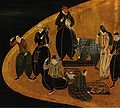Columbian Exchange
| Advanced search |
- About 6 results found and you can help!
The Columbian Exchange also known as the Grand Exchange was a dramatically widespread exchange of animals, plants, culture, human populations (including slaves), communicable disease, and ideas between the Western and Eastern Hemispheres following the voyage to the Americas by Christopher Columbus in 1492. The term was coined in 1972 by Alfred W. Crosby, a historian at the University of Texas at Austin, in his same-titled work of environmental history. The contact between the two areas circulated a wide variety of new crops and livestock which supported increases in population in both hemispheres. Explorers returned to Europe with maize, potatoes, and tomatoes, which became very important crops in Eurasia by the 18th century. Similarly, Europeans introduced manioc and the peanut to tropical Southeast Asia and West Africa, where they flourished and supported growth in populations on soils that otherwise would not produce large yields.
- See also: Wikipedia
| The Columbian Exchange: Plants, Animals, and Disea... The Columbian Exchange: Plants, Animals, and Disease between the Old and New Worlds www.eoearth.org/.../Columbian_exchange:_plants,_animals,_and_disease_between_the_Old_and_New_World - Web |
| Worlds Together, Worlds Apart Worlds Together, Worlds Apart www.wwnorton.com/worlds/index/ - Web |
| New study blames Columbus for syphilis spread New study blames Columbus for syphilis spread uk.reuters.com/article/oddlyEnoughNews/idUKN1443055520080115 - Web |
Gallery for «Columbian Exchange»
Average relevance
| Foods that Changed the World Foods that Changed the World www.accessexcellence.org/RC/Ethnobotany/page5.html - Web |
| The Columbian Exchange The Columbian Exchange www.shmoop.com/intro/history/us/the-columbian-exchange.html - Web |
| NBC News piece on Columbian Exchange NBC News piece on Columbian Exchange www.icue.com/portal/site/iCue/flatview/?cuecard=1518 - Web |




